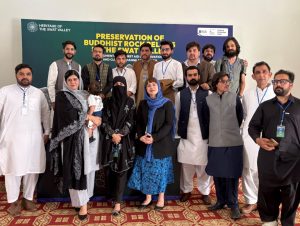Milestone project to preserve Buddhist Heritage in Pakistan completed
 HERITΛGE is proud to announce the completion of the ‘Preservation of Buddhist Rock Reliefs in the Swat Valley: Documentation, First Aid Conservation, and Climate Change Adaptation‘ project, realised in collaboration with EssaNoor Associates, the Directorate of Archaeology and Museums KP, and the Italian Archaeological Mission in Pakistan, and made possible thanks to the support of the British Council’s Cultural Protection Fund.
HERITΛGE is proud to announce the completion of the ‘Preservation of Buddhist Rock Reliefs in the Swat Valley: Documentation, First Aid Conservation, and Climate Change Adaptation‘ project, realised in collaboration with EssaNoor Associates, the Directorate of Archaeology and Museums KP, and the Italian Archaeological Mission in Pakistan, and made possible thanks to the support of the British Council’s Cultural Protection Fund.
Swat Valley in northern Pakistan is home to some of the most significant remnants of the ancient Gandhara civilization. Among these are Buddhist rock reliefs and inscriptions, likely carved in the 7th or 8th century BC, which are now under threat from natural erosion, human activity, and the escalating impacts of climate change.
In response to these emerging challenges, the project adopted a multi-phase strategy encompassing digital documentation, emergency conservation, local capacity development, sustainable tourism, and climate resilience initiatives.
Through extensive field surveys, the project digitally recorded 78 Buddhist rock reliefs using high-resolution photography, 3D scanning, and interactive geographic mapping. Emergency stabilization measures were also carried out at several vulnerable sites, providing necessary ‘first aid’ to prevent further deterioration. A major milestone was the launch of the project website, which offers free access to 3D models, maps, and comprehensive documentation of these heritage sites. The platform supports research, education, and site management while promoting global engagement with Swat’s rich cultural heritage.
The local communities and institutions were engaged throughout the project to raise awareness and empower them to become custodians of these invaluable heritage sites through grassroots discussions and workshops. Thirteen heritage professionals and seven local community members were trained in digital preservation skills to ensure that the knowledge and tools for conserving the heritage are sustained locally, empowering the community to manage and protect their own cultural resources. The project also recorded six oral testimonies, preserving the intangible heritage of the local community. These stories reflect the lasting impact of Buddhist influence in the Swat Valley, highlighting traditional crafts like Gandharan wooden art, stone masonry, and shawl embroidery, which have been inspired by centuries of Buddhist heritage.
In addition to heritage conservation, the project identified sustainable tools for both preservation and economic development. The development of hiking trails and eco-tourism facilities was proposed to promote local tourism and provide sustainable income for rural communities. Alternative livelihoods through eco-tourism, local crafts, and medicinal plant cultivation are also encouraged by the initiative that aims to ensure economic stability in the region.
Closing Ceremony
 The Swat Museum hosted a project closing event on 15 April 2025, attended by approximately 200 people, including students, heritage practitioners, local community representatives, and international experts. The ceremony included a presentation by project team, detailing the objectives and accomplishments, as well as the official launch of the website. A panel discussion, chaired by HERITΛGE’s Dr. Maja Kominko, gathered professionals from both the academic and grassroots communities. The panel addressed the cultural significance of Buddhist heritage in Swat, the significance of community participation in conservation, and the adaptation to the impacts of climate change on heritage.
The Swat Museum hosted a project closing event on 15 April 2025, attended by approximately 200 people, including students, heritage practitioners, local community representatives, and international experts. The ceremony included a presentation by project team, detailing the objectives and accomplishments, as well as the official launch of the website. A panel discussion, chaired by HERITΛGE’s Dr. Maja Kominko, gathered professionals from both the academic and grassroots communities. The panel addressed the cultural significance of Buddhist heritage in Swat, the significance of community participation in conservation, and the adaptation to the impacts of climate change on heritage.
The guests were guided through a thoughtfully curated exhibit showcasing the project’s key outputs, including photographic documentation, interactive maps, and 3D-models. Team members were present to explain the conservation methods employed throughout the project and to demonstrate the digital equipment used in the preservation process. The ceremony concluded with the presentation of shields and certificates to honor significant contributions. Project stakeholders and members of the public reaffirmed their commitment to safeguarding Swat’s cultural heritage for the benefit of future generations.
The ‘Preservation of Buddhist Rock Reliefs in the Swat Valley’ project underscores the increasing significance of integrating digital technologies, emergency conservation, community engagement, sustainable tourism, and climate resilience into contemporary heritage conservation practices. It also serves as a model for future initiatives aimed at safeguarding vulnerable cultural heritage sites.
For additional information and access to digital documentation, visit www.heritageofswatvalley.com.
